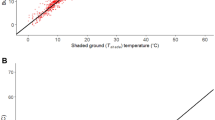Summary
During the month of February 1979, several hundred hatchling land iguanas (Conolophus pallidus) were observed emerging from their natal burrows in a 2 ha communal nesting area on Isla Santa Fe, Galapagos Islands. During this emergence, as many as nine Galapagos hawks were observed to patrol the nesting area and attack hatchling iguanas.
The hypothesis that the ability of hatchling land iguanas to escape predation could be influenced by the interaction of the physiological state of the lizards and the thermal environment was analyzed using (1) empirical data on the effect of body temperature (T b) on locomotory ability of iguanas and (2) biophysical modeling of the T b's of hatchlings under natural conditions. This hypothesis was tested by assessing the success of natural hawk attacks on lizards exposed to different thermal environments.
During those periods when predicted T b's of hatchlings were always <32°C, (at which temperatures land iguanas were shown to have less than maximal ability to sprint rapidly) hawks were successful in 67% of the observed attacks. However, when T b's of hatchlings were always ≧32° C, hawks were successful on only 19% of observed attacks. During periods when hatchling T b's could be <32° C or 32–40° C (depending upon which microhabitat the hatchling occupied before the attack), the hawks were successful in 46% of the observed attacks.
These data indicate that the physical environment, as mediated through the physiological state of the lizards and to correlated locomotary abilities, significantly affects the ability of hatchling land iguanas to escape predation.
Similar content being viewed by others
References
Bakken GS, Gates DM (1975) Heat transfer analysis of animals: some implications for field ecology, physiology and evolution. In: D M Gates and RB Schmerl (eds), Perspectives in Biophysical Ecology, Springer, Berlin Heidelberg New York pp. 255–290
Bartleft PN, Gates DM (1967) The energy budget of a lizard on a tree trunk. Ecology 48:315–322
Burghardt GM, Greene HW, Rand AS (1977) Social behavior in juvenile green iguanas: life at a reptile rookery. Science 195:689–691
Campbell GS (1978) An introduction to Environmental Biophysics. Springer. Berlin, Heidelberg New York p 159
Christian KA, Tracy CR (1981) Reproductive behavior of Galapagos Land Iguanas (Conolophus pallidus) on Isla Santa Fe, Galapagos. In: Iguanas of the World: Behavior, Ecology, and Conservation. GM Burghardt and AS Rand (eds), Garland STPM Press, New York
Curio E (1976) The ethology of predation. Springer. Berlin Heidelberg New York p 250
deVries T (1973) The Galapagos Hawk: an eco-geographical study with special reference to its systematic position. Vrije Universiteit te Amsterdam.
Fox SF (1978) Natural selection on behavioral phenotypes of the lizard Uta stansburiana. Ecology 59:834–847
Gates DM (1962) Energy exchange in the biosphere. Harper and Row, New York
Greene HW, Burghardt GM, Dugan BA Rand AS (1978) Predation and the defensive behavior of green iguanas (Reptilia, Lacertilia, Iguanidae). J Herp 12(2):169–176
Greenwald OE (1974) Thermal dependence of striking and prey capture by gopher snakes. Copeia 1974:141–148
Heatwole H (1976) Reptile Ecology. U of Queenland Press, St Lucia p 178
Huey RB, Slatkin M (1976) Costs and benefits of lizard thermoregulation. Quart Rev Biol 51:363–384
Huey RB, Stevenson RD. Integrating thermal physiology and ecology of ectotherms: a discussion of approaches. Amer Zool 19:357–366
Kowalski GJ, Mitchell JW (1976) Heat transfer from spheres in the naturally turbulent, outdoor environment. J Heat transf 98 (4):649–653
Mason HL, Langenheim JH (1957) Language analysis and the concept environment. Ecology 38:330–340
Mitchell JW (1976) Heat transfer from spheres and other animal forms. Biophysical J 16:561–569
Porter WP, Mitchell JW, Beckman WA and DeWitt CB (1973) Behavioral implications of mechanistic ecology: Thermal and behavioral modeling of desert ectotherms and their microenvironment. Oecologia 13:1–54
Porter WP, Gates DM (1969) Thermodynamic equilibria of animals with environment. Ecol Monogr. 39:245–270
Porter WP, James FC (1979) Behavioral implications of mechanistic ecology II: The African Rainbow Lizard Agama agama. Copeia 1979:594–619
Porter WP, Mitchell JW, Beckman WA, Tracy CR (1975) Environmental constraints on some predator-prey interactions. In: Perspectives of biophysical ecology, DM Gates and RB Schmerl (eds), p. 347–364. Springer. Berlin Heidelberg New York
Porter WP, Tracy CR (1974) Modeling the effects of temperature changes on the ecology of the garter snake and leopard frog. In: Thermal Ecology, J W Gibbons and RR Shritz (eds), US At Energy Comm Rep CONF-730505. p 670 p 594–609
Pough FH (1980) The advantages of ectothermy for tetrapods. Am Nat 115:92–112
Rand AS (1964) Inverse relationship between temperature and shynes in the lizard Anolis lineatopus. Ecology 45:863–864
Riechert SE, Tracy CR. Thermal balance and prey availability: bases for a model relating web-site characteristics to spider reproductive success. Ecology 56:265–284
Spotila JR, Lommen PW, Bakken GS, Gates DM (1973) A mathematical model for body temperatures of large reptiles: implications for dinosaur ecology. Am Nat 107:391–404
Tracy CR (1976) A model of the dynamic exchanges of water and energy between a terrestrial amphibian and its environment. Ecol Monogr 46:293–326
Wiewandt TA (1981) Nesting patterns of iguanine lizards. In: Iguanas of the world: Behavior, Ecology, and Conservation. GM Burghardt and AS Rand (eds) Garland STPM Press New York
Author information
Authors and Affiliations
Rights and permissions
About this article
Cite this article
Christian, K.A., Tracy, C.R. The effect of the thermal environment on the ability of hatchling Galapagos land iguanas to avoid predation during dispersal. Oecologia 49, 218–223 (1981). https://doi.org/10.1007/BF00349191
Received:
Issue Date:
DOI: https://doi.org/10.1007/BF00349191




